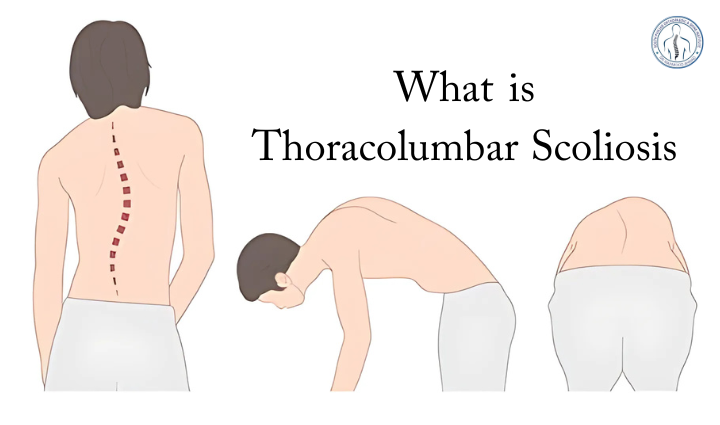What is Thoracolumbar Scoliosis
Thoracolumbar scoliosis is a condition characterized by an abnormal sideways curvature that affects the lower thoracic and upper lumbar regions of the spine. Gaining a clear understanding of thoracolumbar scoliosis, its symptoms, causes, and available treatments is essential for effectively managing the condition and improving the quality of life for those affected.
What is Thoracolumbar Scoliosis?
This condition is a specific form of scoliosis that impacts the mid-back and lower spine regions. The severity of the curvature in scoliosis can range from mild to severe, with potential effects on posture, mobility, and overall health.
Unlike scoliosis that involves only the thoracic or lumbar sections, thoracolumbar scoliosis spans both regions, which can pose unique challenges in terms of diagnosis and treatment.
Recognizing Thoracolumbar Scoliosis Symptoms
The following are common signs of thoracolumbar scoliosis:
- Uneven Shoulders or Waist: One side may appear higher or more prominent than the other.
- Visible Spinal Curvature: The spine may visibly deviate to one side.
- Back Pain or Discomfort: Persistent pain in the affected region.
- Muscle Fatigue: Strain on spinal muscles can lead to tiredness.
If untreated, these symptoms of thoracolumbar scoliosis can disrupt daily life and potentially lead to complications.
Causes of Thoracolumbar Scoliosis
The origins of thoracolumbar scoliosis can be attributed to a combination of genetic and environmental factors.
Genetic Influences
- A family history of scoliosis increases the likelihood of developing scoliosis.
- Genetic disorders such as Marfan syndrome or Ehlers-Danlos syndrome may predispose individuals to scoliosis.
Environmental Contributions
- Environmental Contributions: Poor posture, prolonged sedentary behavior, and limited physical activity can exacerbate thoracolumbar scoliosis and may also contribute to thoracolumbar junction syndrome.
Additional Risk Factors
- Congenital Spinal Deformities: Present at birth and may lead to scoliosis.
- Neuromuscular Conditions: Disorders such as muscular dystrophy and cerebral palsy can contribute to thoracolumbar scoliosis.
Thoracolumbar Scoliosis in Children
Importance of Early Detection
Early identification of scoliosis during childhood is vital for effective intervention. Routine screenings, along with monitoring for signs like uneven shoulders, a protruding ribcage, or an asymmetric waist, are crucial.
Impact on Growth
Thoracolumbar scoliosis can hinder physical symmetry and development, potentially causing psychological challenges, including self-consciousness or social anxiety in children.
Treatment Approaches
- Observation: Regular check-ups for mild cases to monitor progression of scoliosis.
- Bracing: Helps prevent the worsening of curvature and is particularly effective during growth spurts.
- Surgery: In severe cases, surgery may be necessary to correct and stabilize the spine affected by thoracolumbar scoliosis.
Thoracolumbar Scoliosis Treatments in Multan
Seeking Specialized Care
For those in Multan, consulting an experienced specialist is key. Dr. Mahmood Ahmad is a leading expert in thoracolumbar scoliosis treatment, offering personalized care tailored to each patient’s unique condition.
Non-Surgical Treatments
- Physical Therapy: Strength-building and posture-improving exercises play a pivotal role in managing thoracolumbar scoliosis. Recommended activities include:
- Stretching: Enhances flexibility and reduces stiffness.
- Core Strengthening: Provides better spinal support.
- Balance Training: Improves overall alignment and coordination.
- Bracing: Used to control and sometimes reduce spinal curvature, especially in growing children with scoliosis.
Surgical Interventions
Surgery is typically recommended for severe cases of scoliosis where the curvature is progressing and causing significant issues.
- Spinal Fusion: This procedure involves stabilizing the spine by fusing vertebrae together using metal rods, screws, and bone grafts.
- Advanced Instrumentation Techniques: Specialized instruments are used to straighten and secure the spine affected by thoracolumbar scoliosis.
Recovery and Post-Surgery Care
Rehabilitation is essential for a successful recovery after surgery. Physical therapy helps restore strength, flexibility, and mobility for those with scoliosis. Long-term follow-up ensures the spine remains stable and that the treatment has achieved its desired outcomes.
FAQs
Can thoracolumbar scoliosis be corrected?
Another successful non-surgical treatment for scoliosis, particularly in developing youngsters, is bracing. Depending on the location and degree of curvature, various brace types can be employed. In order to stop future curvature progression, the brace applies pressure to the spine.
What are the side effects of thoracic scoliosis?
Uneven shoulders, hips, a perceptible curvature of the spine, and possible organ compression that results in pain or difficulty breathing are some of the symptoms. Dextroscoliosis can cause the body to tilt or lean to one side, and depending on the degree of curvature, it might compress the organs, making respiration and circulation difficult.
Is thoracolumbar scoliosis a disability?
Severe symptoms of scoliosis might include breathing and movement difficulties, as well as generalized pain. Many agencies and organizations may consider scoliosis to be a disability when these symptoms make it impossible for a person to work.
What is the best treatment for scoliosis?
Spine fusion is the most often performed spine surgery to address scoliosis. In order to keep the spine in a more straight position, the spine is fused to bone grafts or substitutes during this treatment.
How to sleep with thoracolumbar scoliosis?
The ideal sleeping posture for scoliosis is usually lying on your back since it keeps your entire spine long and prevents twisting and bending. Nonetheless, a lot of people choose sleeping on their stomachs or sides.
At what age is it too late to fix scoliosis?
Although early detection and intervention are best, scoliosis can always be addressed at any time. Prompt care in childhood and adolescence can stop the disease’s progression and lessen the need for more intrusive procedures in later life.
Final Thoughts
Thoracolumbar scoliosis is a complex condition requiring timely diagnosis and a comprehensive treatment plan. Early recognition of symptoms, understanding potential causes, and consulting a skilled specialist are the cornerstones of effective management.
In Pakistan Multan, Dr. Muhamad Mahmood Ahamd expertise offers patients the best chance of a positive outcome. If you or a loved one experiences symptoms of thoracolumbar scoliosis, reach out to a medical professional to explore your options for care and recovery.
- Razia Saeed Hospital 17-E Near Eid Gah، Chowk، Officers Colony, Multan, Punjab
- 0300 0777790
- [email protected]




